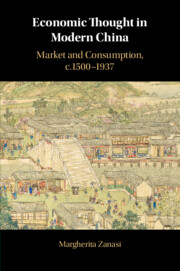Book contents
- Economic Thought in Modern China
- Economic Thought in Modern China
- Copyright page
- Dedication
- Contents
- Maps
- Acknowledgments
- Chronology
- Maps
- Introduction
- 1 The Political and Intellectual Framework
- 2 Efficient Markets, Jiangnan’s Luxury, and Productive Consumption (1500–1800)
- 3 Scarcity Revisited: Population Growth, Frugality, and Self-Strengthening (1800–1911)
- 4 Nation Building, Strategic Markets, and Frugal Modernity in the Early Decades of the Republic of China (1912–1930s)
- Conclusion
- Glossary
- Bibliography
- Index
Introduction
Published online by Cambridge University Press: 16 April 2020
- Economic Thought in Modern China
- Economic Thought in Modern China
- Copyright page
- Dedication
- Contents
- Maps
- Acknowledgments
- Chronology
- Maps
- Introduction
- 1 The Political and Intellectual Framework
- 2 Efficient Markets, Jiangnan’s Luxury, and Productive Consumption (1500–1800)
- 3 Scarcity Revisited: Population Growth, Frugality, and Self-Strengthening (1800–1911)
- 4 Nation Building, Strategic Markets, and Frugal Modernity in the Early Decades of the Republic of China (1912–1930s)
- Conclusion
- Glossary
- Bibliography
- Index
Summary
This book explores the evolution of Chinese economic thought from the late Ming and Qing periods (1500s–1911) through the first two decades of the Republic (1912–1930s). It focuses on the debates over the two closely related ideas of market and consumption in order to understand Chinese officials’ and intellectuals’ perceptions of their roles in the economy of the empire – or, after 1912, in that of the Republic. The results of this study challenge the chronological and spatial narrative of global economic modernization in two main ways. First, the study locates in China, rather than in Europe, the earliest formulations of the ideas of a self-regulating market and consumption-driven economy. This point is not intended to initiate a competition regarding who was first to generate theories that were to play a crucial role in the development of economic liberalism in eighteenth-century Europe, but to emphasize the ability of regions other than Western Europe to think about the economy in innovative ways in response to changing circumstances. Second, this study challenges the neoliberal narrative of economic modernization as a march toward increased reliance on an unregulated market. This highly ideologized narrative of developmental determinism mythologizes the power of the unregulated market as the main engine for economic development regardless of historical and geopolitical circumstances. China offers a case against this form of determinism. As discussed in Chapter 3, starting from the 1800s China’s particular geopolitical and historical circumstances appeared to most Chinese officials and intellectuals to require a retreat from earlier pro-market policies and inspired them to attempt the realization of a hybrid system that combined reliance on market forces with targeted state intervention as the most efficient model for addressing China’s specific needs.
- Type
- Chapter
- Information
- Economic Thought in Modern ChinaMarket and Consumption, c.1500–1937, pp. 1 - 15Publisher: Cambridge University PressPrint publication year: 2020

